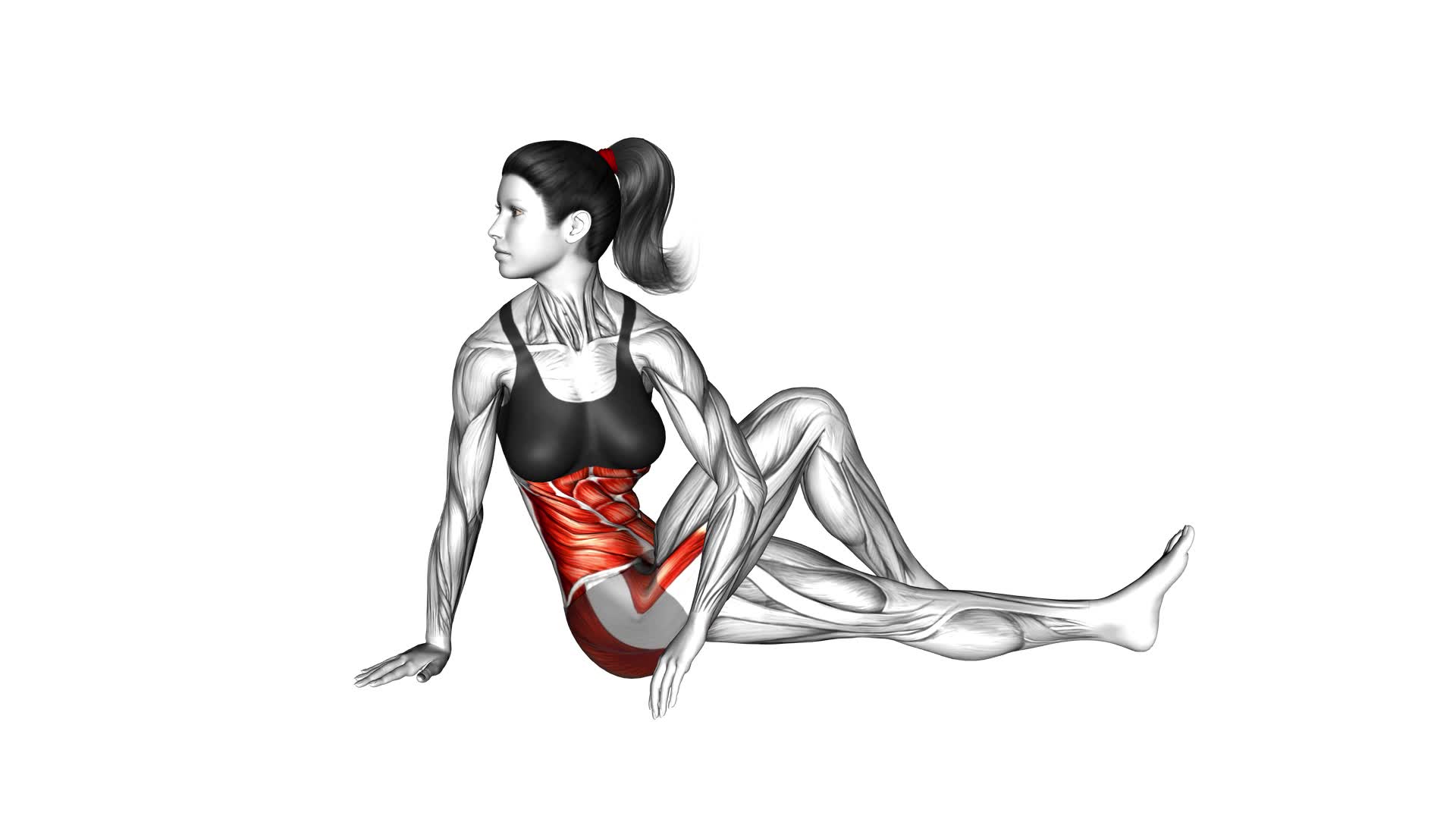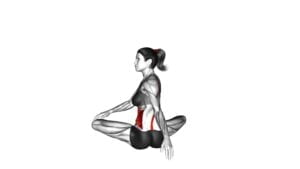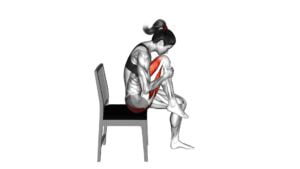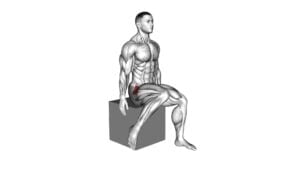Seated Knee-up Rotation Stretch (female) – Video Exercise Guide & Tips

Ready to improve your flexibility and strengthen your core?
Watch This Exercise Video
Check out our video exercise guide for the seated knee-up rotation stretch.
This stretch is perfect for females looking to target their lower body and increase mobility.
With our step-by-step instructions and helpful tips, you'll learn the correct form and avoid common mistakes.
Whether you're a beginner or have limited flexibility, we've got modifications to suit your needs.
Get ready to incorporate this effective stretch into your workout routine!
Key Takeaways
- Targets multiple muscle groups
- Increases flexibility in lower body
- Strengthens core muscles
- Improves mobility
Benefits of the Seated Knee-up Rotation Stretch
Discover the benefits of the Seated Knee-up Rotation Stretch to improve your flexibility and strengthen your core. This stretch is a great way to target multiple muscle groups while sitting in a chair. One of the benefits of this stretch is that it can be easily modified to accommodate different chair heights and body types. If you have a shorter chair, you can place a cushion or folded towel under your hips to raise them up and create a more comfortable position. On the other hand, if you have a taller chair, you can adjust the position of your feet and knees to find the most effective stretch for your body.
To maximize the effectiveness of the Seated Knee-up Rotation Stretch, it's important to focus on proper form and alignment. Sit up tall with your feet flat on the floor and your knees bent at a 90-degree angle. Engage your core muscles and slowly lift one knee towards your chest while rotating it outwards. Hold the stretch for a few seconds and then lower your leg back down. Repeat on the other side. Remember to breathe deeply and relax into the stretch, avoiding any pain or discomfort.
Correct Form for the Seated Knee-Up Rotation Stretch
To perform the Seated Knee-Up Rotation Stretch with correct form, follow these steps.
Start by sitting on the floor with your legs extended in front of you. Bend your left knee and bring it up towards your chest, placing your left foot on the ground next to your right knee. Place your left hand on the ground behind you for support.
Now, twist your torso to the left, bringing your right elbow to the outside of your left knee. Hold this position for 15 to 30 seconds, feeling a gentle stretch in your lower back and hips. Repeat on the other side by bending your right knee and twisting your torso to the right.
This seated knee-up rotation stretch helps improve flexibility in your lower back, hips, and spine. It also helps to relieve tension and tightness in these areas.
There are variations you can try for the seated knee-up rotation stretch. For example, you can use a yoga block or a bolster under your hips for added support. You can also experiment with different hand placements, such as placing your hands on your knees or clasping your hands in front of your chest.
Remember to listen to your body and only go as far as is comfortable for you.
Tips for Maximizing the Effectiveness of the Stretch
To maximize the effectiveness of the stretch, use proper form and engage your core muscles throughout the exercise. By maintaining good form and activating your core, you can ensure that the stretch targets the right muscles and maximizes flexibility. Here are some tips to help you get the most out of the seated knee-up rotation stretch.
First, make sure to sit up tall with a straight back. This will help to lengthen your spine and create space for the stretch. Avoid slouching or rounding your back, as this can limit the effectiveness of the stretch.
Secondly, focus on engaging your core muscles throughout the exercise. This will help to stabilize your spine and pelvis, allowing for a deeper and more effective stretch. Imagine pulling your belly button towards your spine to activate your deep core muscles.
Lastly, for advanced practitioners looking to further challenge themselves and maximize flexibility, there are variations you can try. For example, you can add a resistance band or weight to increase the intensity of the stretch. You can also experiment with different arm positions or angles to target different muscles.
Remember to listen to your body and only go as far as feels comfortable. It's important to stretch safely and gradually increase the intensity of the stretch over time. With proper form and a focus on engaging your core, you can maximize the effectiveness of the seated knee-up rotation stretch and improve your flexibility.
Modifications for Beginners or Those With Limited Flexibility
If you're a beginner or have limited flexibility, there are several modifications you can make to the seated knee-up rotation stretch.
One option is to use a chair for support, which can help to alleviate strain on your muscles.
You can also try gentle stretching variations, such as reducing the range of motion or using props to assist with the stretch.
Lastly, consider incorporating flexibility-building modifications, such as gradually increasing the intensity or duration of the stretch over time.
Chair Modification Options
Try sitting back in the chair and lifting your knees up towards your chest to modify the seated knee-up rotation stretch for beginners or those with limited flexibility. This chair modification offers a more accessible option for individuals who may struggle with the full range of motion required in the traditional version of the exercise.
By performing the stretch in a seated position, you can still engage the muscles in your lower body and work on improving flexibility without putting excessive strain on your joints. Additionally, you can experiment with different chair heights to find the most comfortable position for you.
Remember to listen to your body and only go as far as feels comfortable. As you progress and increase your flexibility, you can gradually work towards the full seated knee-up rotation stretch.
Gentle Stretching Variations
To modify the seated knee-up rotation stretch for beginners or those with limited flexibility, you can incorporate gentle stretching variations that focus on increasing mobility and range of motion. Here are three gentle stretching techniques to try:
- Seated Knee Lift: Begin in a seated position with both feet flat on the floor. Lift one knee towards your chest while keeping your back straight. Hold for a few seconds, then lower the leg back down. Repeat with the other leg.
- Seated Knee Circles: Sit with both feet flat on the floor and knees bent. Place your hands on your knees and gently circle your knees in a clockwise motion. After a few rotations, switch to counterclockwise.
- Seated Spinal Twist: Sit with your legs extended in front of you. Bend one knee and place the foot flat on the floor. Place the opposite hand on the outside of the bent knee and gently twist your torso towards that side. Hold for a few seconds, then switch sides.
These variations provide a gentle way to stretch the muscles surrounding the knees and improve flexibility. Incorporating these techniques into your stretching routine can help gradually increase your range of motion.
Remember to always listen to your body and adjust the stretches as needed.
Flexibility-Building Modifications
To increase flexibility for beginners or individuals with limited flexibility, incorporate modifications that focus on building range of motion and mobility.
Flexibility exercises and stretching techniques can be modified to suit different levels of flexibility. Start with gentle stretches and gradually increase the intensity as your flexibility improves.
For example, if you find it difficult to touch your toes while standing, you can start by sitting on the ground and reaching towards your toes. As you become more flexible, you can progress to standing stretches.
Another modification is to use props such as blocks or straps to support your body and help you achieve a deeper stretch. Remember to listen to your body and avoid any pain or discomfort during the stretches.
With consistency and patience, you'll gradually improve your flexibility.
Common Mistakes to Avoid During the Seated Knee-Up Rotation Stretch
To ensure the effectiveness and safety of the Seated Knee-Up Rotation Stretch, there are several common mistakes to avoid.
Firstly, make sure to maintain proper knee alignment throughout the exercise, keeping them in line with your toes.
Secondly, engage your core muscles to support your spine and maintain stability.
Lastly, gradually increase the rotation of your torso, avoiding any sudden or jerky movements that could strain your muscles.
Proper Knee Alignment
Ensure proper knee alignment during the Seated Knee-Up Rotation Stretch to avoid common mistakes. The correct alignment of your knees is crucial for effective knee strengthening exercises and knee pain prevention. Here are some tips to help you maintain proper knee alignment:
- Keep your knees facing forward throughout the stretch.
- Align your knees with your toes, making sure they aren't pointing inward or outward.
- Avoid any excessive twisting or torqueing of the knees.
Maintaining proper knee alignment won't only help you avoid injury but also ensure that you're targeting the right muscles during the stretch.
Now that you know how to align your knees correctly, let's move on to the next section and learn how to engage your core muscles for maximum benefit.
Engage Core Muscles
Maintain proper core engagement while performing the Seated Knee-Up Rotation Stretch to avoid common mistakes and maximize the effectiveness of the exercise.
Core engagement refers to activating the muscles of your abdomen, lower back, and pelvis to stabilize your spine and maintain proper alignment. When you engage your core, you create a strong foundation for movement, which helps prevent strain on other muscles and joints.
To engage your core during the Seated Knee-Up Rotation Stretch, focus on drawing your navel towards your spine and bracing your abdominal muscles. This will help stabilize your torso and prevent excessive movement or compensation from other muscles.
Gradually Increase Rotation
As you gradually increase rotation during the Seated Knee-Up Rotation Stretch, be mindful of common mistakes to avoid and maintain proper form.
To ensure you're increasing your range of motion effectively and safely, here are some key points to keep in mind:
- Maintain a tall posture: Sit up straight with your spine aligned and your shoulders relaxed. This will help you engage the correct muscles and prevent unnecessary strain on your back.
- Control the movement: Slowly rotate your torso from side to side, focusing on the stretch in your oblique muscles. Avoid using momentum or jerky movements, as this can lead to injury.
- Listen to your body: Pay attention to any discomfort or pain during the exercise. If you feel any sharp or intense sensations, reduce the range of motion or stop the exercise altogether.
How to Incorporate the Seated Knee-Up Rotation Stretch Into Your Workout Routine
To incorporate the seated knee-up rotation stretch into your workout routine, start by sitting on the floor with your legs extended in front of you. This stretch is a great way to improve flexibility, increase mobility in your hips and lower back, and help prevent injury.
Begin by bending your right knee and placing your right foot on the outside of your left knee. Keep your left leg extended and straight. Sit up tall and place your left hand behind you for support.
Next, twist your torso to the right, using your right arm to gently press against your right knee. Hold this position for 15-30 seconds, feeling a stretch in your lower back and hips.
Release the stretch and repeat on the other side, bending your left knee and placing your left foot on the outside of your right knee. Twist your torso to the left, pressing your left arm against your left knee. Hold for 15-30 seconds.
Incorporating the seated knee-up rotation stretch into your routine is easy. You can do it before or after your workout, or even during a break throughout the day. Aim to stretch each side 2-3 times, gradually increasing the intensity of the stretch over time. Remember to listen to your body and never force the stretch.
Frequently Asked Questions
Can Men Also Perform the Seated Knee-Up Rotation Stretch?
Yes, men can certainly perform the seated knee-up rotation stretch. It isn't limited to women only. This stretch can be beneficial for men's flexibility and overall mobility.
Stretching helps improve muscle flexibility, increases range of motion, and can aid in injury prevention. By incorporating this stretch into your routine, you can enhance your athletic performance and maintain a healthy body.
How Long Should Each Repetition of the Seated Knee-Up Rotation Stretch Be Held For?
To get the most out of the seated knee-up rotation stretch, it's important to know how long to hold each repetition. The benefits of holding stretches for longer durations include improved flexibility and range of motion.
However, there are pros and cons to modifying this stretch. By holding each repetition for about 20-30 seconds, you can effectively stretch your muscles without overstraining them. Remember to listen to your body and adjust the duration based on your comfort level.
Is It Recommended to Use Any Equipment or Props While Performing the Seated Knee-Up Rotation Stretch?
When performing the seated knee-up rotation stretch, using equipment or props can provide added benefits. Props like a resistance band or yoga block can help deepen the stretch and increase flexibility. They can also provide support and stability, especially for beginners or those with limited mobility.
Additionally, modifications such as using a folded blanket or cushion can help make the stretch more comfortable. Incorporating props and modifications can enhance your seated knee-up rotation stretch routine.
Can the Seated Knee-Up Rotation Stretch Help Improve Posture?
The seated knee-up rotation stretch is a great way to improve your posture. By incorporating this exercise into your routine, you can reap the benefits of improved spinal alignment and increased flexibility.
This stretch targets the muscles in your back, hips, and core, helping to strengthen and align them. Regular practice of the seated knee-up rotation stretch can lead to a more upright posture and reduced back pain.
Are There Any Alternative Stretches That Can Be Done for the Same Muscle Groups Targeted by the Seated Knee-Up Rotation Stretch?
Looking for alternatives to the seated knee-up rotation stretch?
You might want to try some Pilates alternatives or standing hip rotations. These exercises can target the same muscle groups and provide a similar stretch.
Pilates offers various movements that can help improve your posture and flexibility.
Standing hip rotations involve standing upright and rotating your hips, which can help improve mobility and flexibility in your lower body.
Give these alternatives a try and see what works best for you!
Conclusion
Incorporating the seated knee-up rotation stretch into your workout routine can offer numerous benefits, such as increased flexibility and improved mobility in your hips and lower back.
By following the correct form and incorporating tips for maximizing its effectiveness, you can ensure that you're getting the most out of this stretch.
Whether you're a beginner or have limited flexibility, there are modifications available to suit your needs.
Avoiding common mistakes will help prevent injury and ensure a safe and effective stretch.

Author
Years ago, the spark of my life’s passion ignited in my mind the moment I stepped into the local gym for the first time. The inaugural bead of perspiration, the initial endeavor, the very first surge of endorphins, and a sense of pride that washed over me post-workout marked the beginning of my deep-seated interest in strength sports, fitness, and sports nutrition. This very curiosity blossomed rapidly into a profound fascination, propelling me to earn a Master’s degree in Physical Education from the Academy of Physical Education in Krakow, followed by a Sports Manager diploma from the Jagiellonian University. My journey of growth led me to gain more specialized qualifications, such as being a certified personal trainer with a focus on sports dietetics, a lifeguard, and an instructor for wellness and corrective gymnastics. Theoretical knowledge paired seamlessly with practical experience, reinforcing my belief that the transformation of individuals under my guidance was also a reflection of my personal growth. This belief holds true even today. Each day, I strive to push the boundaries and explore new realms. These realms gently elevate me to greater heights. The unique combination of passion for my field and the continuous quest for growth fuels my drive to break new ground.







